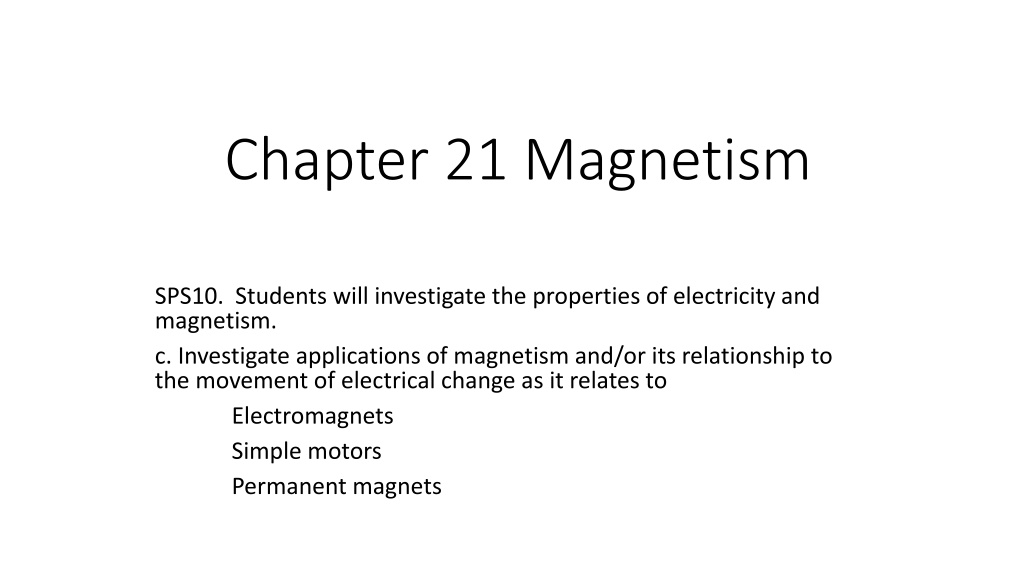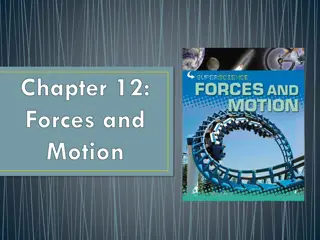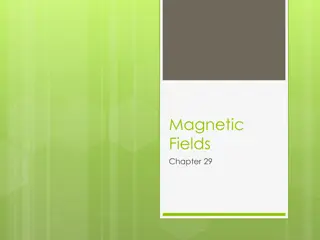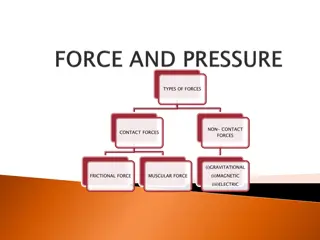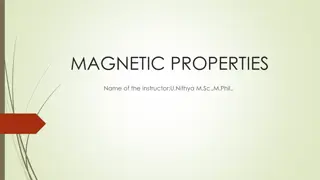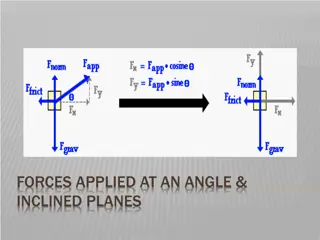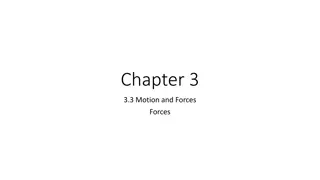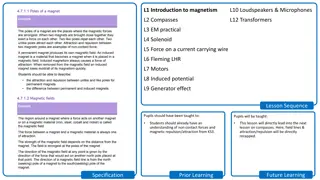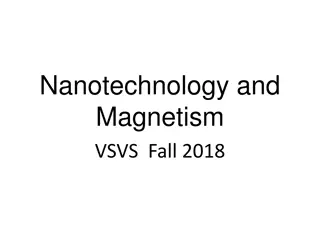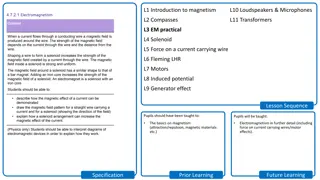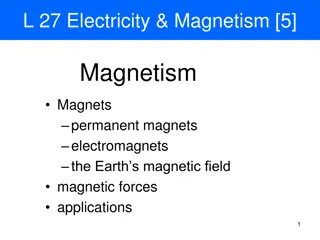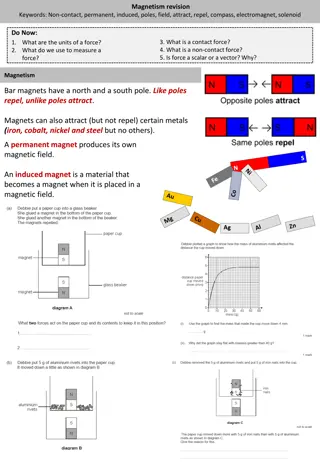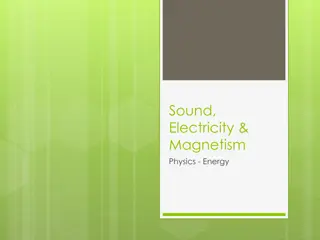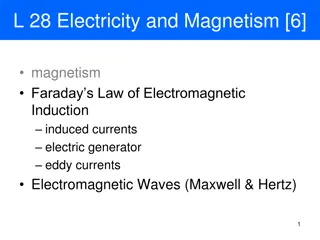Exploring Magnetism: Properties, Forces, and Applications
Investigate the properties of magnetism, magnetic forces, magnetic fields, and magnetic materials. Understand how magnetic forces work, the behavior of magnetic fields, and the significance of magnetic materials such as ferromagnetic substances. Explore applications like electromagnets, simple motors, and permanent magnets while delving into the magnetic field surrounding Earth and its impact on compass navigation.
Download Presentation

Please find below an Image/Link to download the presentation.
The content on the website is provided AS IS for your information and personal use only. It may not be sold, licensed, or shared on other websites without obtaining consent from the author. Download presentation by click this link. If you encounter any issues during the download, it is possible that the publisher has removed the file from their server.
E N D
Presentation Transcript
Chapter 21 Magnetism SPS10. Students will investigate the properties of electricity and magnetism. c. Investigate applications of magnetism and/or its relationship to the movement of electrical change as it relates to Electromagnets Simple motors Permanent magnets
A. Magnetic Forces Magnetic force is the force a magnet exerts on another magnet, on iron or a similar metal, or on moving charges. Magnetic force is one aspect of electromagnetic force Magnetic (like electric forces) act over a distance and is stronger at a closer distance. Magnetic poles are the regions where the magnet s force is strongest, one is the north pole and one is the south pole. Like magnetic poles repel one another, and opposite magnetic poles attract one another
B. Magnetic Fields Magnetic field surrounds a magnet and can exert magnetic forces. A magnetic field, which is strongest near the poles, will either attract or repel another magnet that enters the field. The field begins near the north pole and ends at the south pole. http://www.magnetic-shield.com/images/faq/flux-images.jpg
1. Magnetic Fields around Magnets Using iron filings will help see how magnetic fields interact. Magnetic field surrounds every magnet, the 1stpicture shows how they start and end at the poles 2ndpicture shows how two similar magnets repel each other, notice the field lines push away from each other. 3rdpicture show how two opposite magnet poles attract each other, notice that the field lines line up.
Magnetic Field Around Earth http://www.magnet.fsu.edu/education/tutorials/magnetminute/images/magneticfield.jpg Earth is like a giant magnet surrounded by a magnetic field Magnetosphere is the area surrounding Earth that is influenced by this field Compass points north because it aligns with earth s magnetic field Magnetic declination is the angle between the direction to true north and to magnetic north
C. Magnetic Materials Electrons move around the nucleus, and the spin of each electron causes it to act like tiny magnets. In many materials the electrons is paired with another and the magnetic effects mostly cancel each other Other materials have one or more unpaired electron and this unpaired electron produces magnetic fields In few materials the unpaired electrons make a strong magnetic field (iron, nickel, cobalt) Magnetic domain is a region that has a very large number of atoms with aligned magnetic fields Ferromagnetic material can be magnetized because it contains magnetic domains When a material is magnetized most of its magnetic domains are aligned.
1. Nonmagnetized Materials A material that is ferromagnetic does not mean it is a magnet If the domains of the material are aligned randomly then the magnetization of the domains is canceled
2. Magnetized Materials You can magnetize a nonmagnetized ferromagnetic material by placing it in a magnetic field Image below show the alignment of magnetic domains in magnetized iron. In some materials the domains stay aligned for a long time, these are called permanent magnets Heat or a jarring impact can realign the domains in a permanent magnet If you cut a magnet in it will still have a north and south pole A magnet can never have just a north pole or just a south pole
2. Magnetized Materials http://my.execpc.com/%7Erhoadley/images/magdom4.gif
21.2 Electromagnetism Unlike electric charges attract one another and like electric chares repel one another Unlike poles attract one another and like poles repel one another Electromagnetic force is the force associated with charged particles, which has two aspects: electric force and magnetic force Electric force results from charged particles Magnetic force usually results from the movement of electrons in an atom
1. Magnetic Fields around moving charges Moving electric charges create a magnetic field The charges may be vibrating charges that produce electromagnetic waves or may be moving charges in a wire Magnetic field lines form circles around a straight wire carrying a current. Right hand rule is when you point thumb of right hand in direction of current, your fingers curve in the direction of the magnetic field
2. Forces Acting on Moving Charges Recall electric field exerts a force on an electric charge The force is either in the same direction as the electric field or in the opposite direction (depending on charge) A charge moving in a magnetic field will be deflected in a direction perpendicular to both the magnetic field and the velocity of the charge If a current-carrying wire is in a magnetic field, the wire will be pushed in a direction perpendicular to both the field and the direction of the current.
3. Solenoids and Electromagnets If you loop a current-carrying wire many times to make a coil the magnetic fields of the lops combine so that the coiled wires acts like a bar magnets Solenoid is a coil of current-carrying wire that produces a magnetic field If you place a ferromagnetic material (iron rod or nail) the strength of the magnetic field increases. Electromagnetic is a solenoid with a ferromagnetic core Changing the current in an electromagnet controls the strength and direction of its magnetic field
3. Solenoids and Electromagnets Hair dryers, telephones, and doorbells utilize electromagnets The strength of an electromagnet depends on the current in the solenoid, number of loops in the coil and the type of ferromagnetic core. Greater current produces a stronger magnetic field Increasing the number of turns while keeping the current the same will increase the field strength Cores that are easily magnetized make stronger electromagnets
B. Electromagnetic Devices Electromagnets can convert electrical energy into motion that can do work Electromagnetic devices such as galvanometers, electric motors, and loudspeakers change electrical energy into mechanical energy.
1. Galvanometer Galvanometer a device that uses a solenoid to measure small amounts of current. The solenoid is attached to a spring that is free to rotate about an iron core and placed between poles of permanent magnets When there is a current in the solenoid s coils the resulting magnetic field attempts to align with the field of the permanent magnets The greater the current the more the solenoid rotates. A fuel gauge is an example of a galvanometer
2. Electric Motors Electric motor is a device that uses an electromagnet to turn an axle A battery supplies current to a loop of wire through the commentator As the commentator turns the direction of current switch back and forth The coil s magnetic field keeps switching direction and this turns the coil about an axle For each rotation of the wire loop, the current produced by the generator reverses direction or alternates Video: Super Simple Electric Motor
3. Loudspeakers A loudspeaker contains a solenoid placed around one pole of a permanent magnet The current in the wires entering the loudspeaker changes direction and increases or decreases to reproduce music, voices or other sounds The change in current produces a change in magnetic field in the solenoid coil Magnetic forces cause motion that produce sound waves
